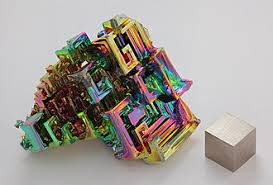
Bismuth: A Remarkable Metal with Crystal Geometry
Geological Profile of Bismuth
Bismuth is a post–transition metal, chemical symbol Bi, atomic number 83. Although often alloyed for practical uses, native bismuth crystals form stunning hoppered, stair‑step structures with iridescent faces. These geometric shapes create hollow, step‑like crystals—with colours from pink and lilac to green and blue, due to light interference on the oxide layer.
-
Composition & structure: Pure bismuth crystallises in a rhombohedral lattice. On the Mohs scale, it is soft (2–2.5), so natural crystals are delicate and often lab‑grown to preserve their iconic form.
-
Colour range: Iridescent oxide patinas lend a rainbow sheen, frequently seen in specimens sold as art or specimen jewellery.
-
Global occurrence: Bismuth is found in hydrothermal veins alongside tungsten, silver, tin, and gold. Key deposits include Bolivia, China, Mexico, and Russia.

Energetic Significance & Healing Uses
Though not a crystal, bismuth is valued in metaphysical circles:
-
Transformation & creativity: Its rainbow surfaces symbolise a bridge between physical and spiritual realms, activating transformation and new beginnings.
-
Clarity & insight: The clear, angular formations encourage objective thinking and problem‑solving.
-
Grounding energy: As a heavy crystal, it stabilises aura fields, especially when one feels scattered or over‑stimulated.
Practitioners often keep a bismuth specimen on their desk or in their healing space—as a tool for focus, clarity, and meditative alignment.
Collecting Value & Natural Form
Authentic bismuth crystals, whether synthetic or rare natural specimens, are prized for:
-
Unique geometry: The hopper structure is both mathematical and organic—a rare combination in the mineral world.
-
Iridescent palette: No two specimens reflect light in the same way, which makes each piece distinctive.
-
Display presence: Larger crystals command attention on a shelf or curated cabinet, often seen in mineral collections.
Collectors seek specimens without damage to the crystal edges, as any imperfection can quickly detract from the visual appeal.
Bismuth in Jewellery: A Modern Metallic Statement
Despite its scientific appearance, bismuth has found a striking niche in raw crystal jewellery, particularly in bold, architectural designs. Though delicate, its hopper formations offer:
-
Futuristic aesthetics: The step-like structures echo Brutalist architecture—appealing to those who love geometric, unconventional adornments.
-
Sculptural uniqueness: Unlike faceted gemstones, bismuth’s raw or semi‑shaped forms are chosen specifically for their natural geometry.
-
Emotive resonance: For wearers drawn to statement pieces, bismuth offers a mix of industrial strength and iridescent charm—perfect for crystal specimen rings or mineral specimen necklaces.
Designers who work with raw metals and avant-garde crystal jewellery often pair bismuth with minimal metal settings, letting the rainbow oxide take centre stage.

Comparison with Other Iridescent Crystals
While bismuth shares visual similarities with titanium quartz and peacock ore (chalcopyrite) due to its rainbow surface, it differs significantly:
| Crystal | Formation | Colour Source | Energy Focus |
|---|---|---|---|
| Bismuth | Metallic hopper crystals | Oxidised surface | Transformation, order |
| Titanium Quartz | Quartz coated in titanium | Vapour deposition | Energy, vitality |
| Peacock Ore | Chalcopyrite with iridescence | Natural tarnishing | Joy, upliftment |
This makes bismuth unique not only in form but also in energetic tone—it combines structure and calm amidst a spectrum of colour.
Mystical Lore & Cultural Glimpses
Though lacking ancient mythological roots, bismuth’s modern metaphysical profile speaks to the contemporary age: a crystal of digital detox, focus, and creative exploration. Some practitioners view it as a bridge between science and soul—honouring both cerebral logic and spiritual depth.
Its rainbow sheen has also led some New Age circles to associate it with the light body, promoting alignment of all chakras and synchrony between the mental and emotional self.
A Closing Note from the Earth
At Oryssia, we often explore materials that challenge conventional ideas of beauty. Bismuth, with its iridescent staircases and otherworldly allure, is one such mineral. Whether kept as a crystal companion on your altar or transformed into a handmade gemstone ring, it reminds us that even the most technical forms can hold deep emotional resonance.